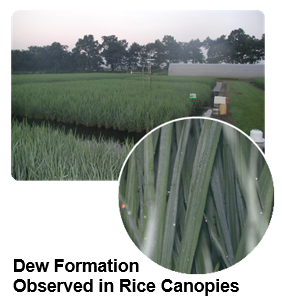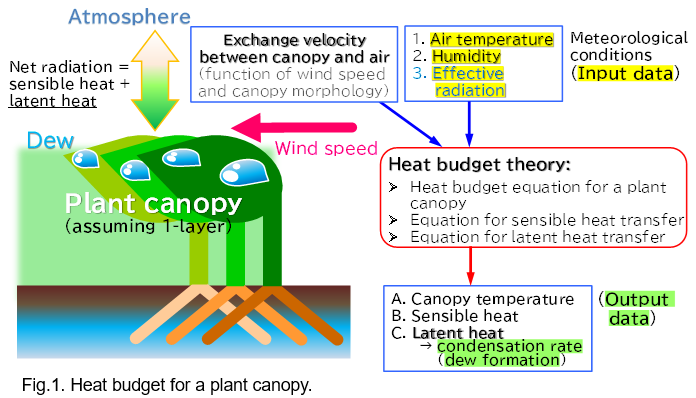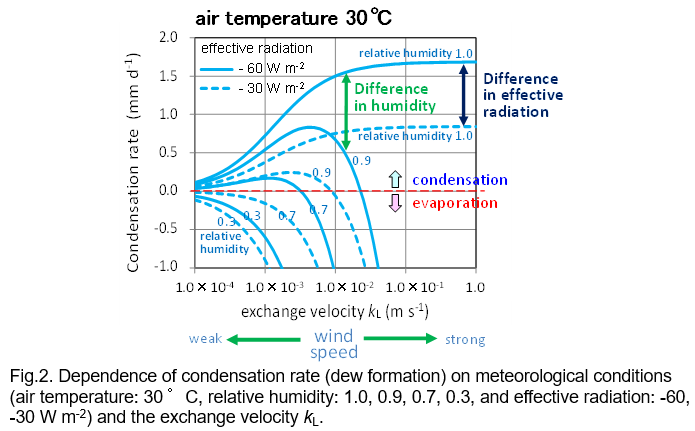Dew formation in plant canopies contributes to the development of a variety of plant diseases such as rice blast. National Agriculture and Food Research Organization (NARO) and Institute of Low Temperature Science at Hokkaido University (ILTS) have, for the first time in the world, revealed the theoretical relationship between the ease of dew formation (condensation rate) in plant canopies and meteorological conditions, based on a principle that considers the exchange of heat and water vapor between the canopy and the atmosphere. The condensation rate in plant canopies varies significantly depending on three meteorological conditions (air temperature, relative humidity, and effective radiation) and differences in the exchange velocity of the plant canopy (i.e., the efficiency of heat exchange between the canopy and the atmosphere). This exchange velocity is influenced by leaf size, canopy density, and wind speed. By applying the findings of this study to crop disease prediction and cultivation management, it is expected to contribute to stable production and quality improvement of various agricultural crops.
Overview

Filamentous fungi and bacteria that cause crop diseases tend to infect plants more easily when the plant surfaces are wet due to condensation or rainfall. In rice cultivation in Japan, moisture accumulation on plant surfaces frequently leads to outbreaks of rice blast disease, resulting in significant agricultural losses. Accurate assessment of condensation occurrence in crop canopies is essential for the development of advanced disease outbreak prediction methods.
However, until now, the meteorological conditions required for dew formation to occur, as well as the quantitative relationship between the dew amount in plant canopies and meteorological conditions, have not been systematically characterized.
In response, NARO and ILTS used a theoretical method based on the principles of heat balance, which considers the exchange of heat and water vapor between the canopy and the atmosphere, to organize the relationship between the ease of dew formation (condensation rate) in plant canopies and meteorological conditions, and for the first time in the world, quantitatively clarified this relationship.
The condensation rate in plant canopies varies significantly depending on three meteorological conditions (air temperature, relative humidity, and effective radiation) as well as the exchange velocity between the canopy and the atmosphere, which is influenced by differences in leaf size, canopy density, and wind speed. Additionally, dew does not form when relative humidity falls below a certain threshold, and this threshold itself varies depending on air temperature and effective radiation.
By utilizing the quantitative relationship between condensation rate in crop canopies and meteorological conditions obtained in this study, it has become available to estimate the dew amount in the canopy and the leaf wetness duration easily and with high accuracy from meteorological data. By applying this method to disease outbreak prediction and crop cultivation management, it is expected to contribute to the stable production and quality improvement of various agricultural crops.


Publication
Maruyama A, Kuwagata T and Watanabe T (2023) Observations on dew formation in the rice canopy and its simulation using a multilayer microclimate model. Journal of Agricultural meteorology, 79, 28-37. https://doi.org/10.2480/agrmet.D-22-00016
Kuwagata T, Maruyama A, Kondo J and Watanabe T (2024) Theoretical study on dew formation in plant canopies based on a one-layer energy-balance model. Agricultural and Forest Meteorology, 354, 109911. https://doi.org/10.1016/j.agrformet.2024.109911
Budget
This research was supported by the JSPS KAKENHI (Grant Numbers: 24K01874, 20H03112, 19H03077, 17H03896), the Environment Research and Technology Development Fund (Grant Numbers: JPMEERF20S11806, S18-2) and the Grant for Joint Research Program of the Institute of Low Temperature Science, Hokkaido University (Grant Numbers: 22G001, 21G001, 20G019).




